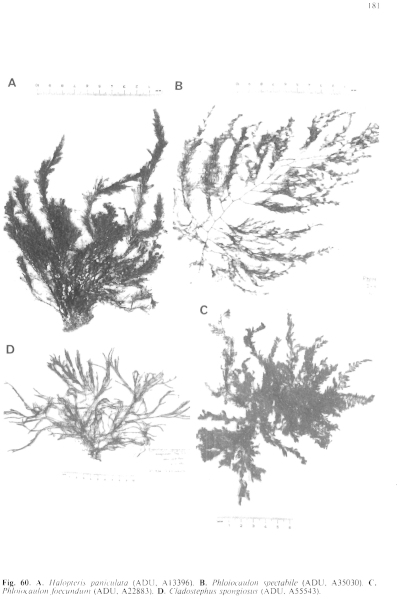|
|
|
|
|
|||||||||||
|
Electronic Flora of South Australia Species Fact Sheet
Phylum Phaeophyta – Order Sphacelariales – Family Stypocaulaceae
Synonyms
Sphacelaria paniculata Suhr 1840: 278.
H. gracilescens (J. Agardh) Womersley 1967: 202.
Sphacelaria hordeacea Harvey I844a: pl. 614.
H. hordeacea (Harvey) Sauvageau 1904: 416, figs 84–88. Lindauer et al. 1961: 170, fig. 22. Moore 1951: 266, figs 3. 4, 25.
spicigera (Areschoug) Moore 1953: 13. Lindauer et al. 1961: 171, fig. 22.
Thallus (Fig. 60A) dark brown, (5–) 10–20 (–30) cm long, densely tufted or with several long, much branched, axes arising from a rhizoidal holdfast 5–25 mm across, with both normal and adventitious laterals, partly basally denuded or not, usually epilithic. Branching of several orders, irregularly radial or subdistichous near apices (Fig. 59A), with laterals many segments apart, with lesser laterals determinate and tapering to a point; mid and lower axes producing descending rhizoids which densely corticate the axes and form the holdfast; phaeophycean hairs absent. Axes (Fig. 59B,C) 200–240 µm in diameter with segments L/B 0.4–0.8, corticated by a layer of small rectangular cells many of which in older axes divide periclinally (Fig. 59C) to form a secondary cortex, within the corticating rhizoids; primary and lesser laterals 120–160 µm in diameter with segments L/B 0.3–0.6 (–0.8); rhizoids arising from pericysts; adventitious branchlets frequent in mid and lower thallus.
Reproduction: Unilocular sporangia (Fig. 59D–F) in dense clusters in axils of bract-like laterals which are reflexed laterally to the left and form a dense quadrifarious spike 1–4 mm long, terminating branchlets and either exserted from or within the tufted thallus; sporangia clavate, borne on a unicellular pedicel (Fig. 59F) arising from the mono- or usually distromatic placenta which spreads radially from within the axil of the bract; sporangia 40–65 µm long and 20–40 µm in diameter. Sexual plants (Fig. 59G,H) with similar but looser spikes but with the bracts reflexed only upwards and not laterally, with mixed axillary clusters of oogonia and antheridia (Fig. 59H) on pedicels 1–3 segments long; oogonia subspherical, 60–80 µm in diameter, antheridia subspherical, 80–100 µm in diameter.
Type from "Neuholland"; in KIEL. Prud'homme van Reine (1972a, p. 134) found the original specimen, with Suhr's handwritten description on the back of the sheet, in KIEL, and records that Reinke had annotated it as "Sphacelaria paniculata Suhr. Original exemplar! Golf von Carpentaria. Ex herb. Suhr." No locality within "Neuholland" was given with the type description and the Gulf of Carpentaria locality is clearly in error, since no Halopteris is known from northern Australia and the limits of the species are within southern Australia and north to Newcastle in N.S.W.
Selected specimens: Pennington Bay, Kangaroo I., S. Aust., sublittoral fringe pool ( Womersley, 23.viii.1950; ADU, A13396). West I., S. Aust., 10 m deep (Shepherd, 13.vi.1970; ADU, A35915). Victor Harbor, S. Aust., drift ( Womersley, 24.vii.1949; ADU, A11199 and 18.iii.1966; ADU, A30045, sexual). 1.3 km off Cape Northumberland, S. Aust., 15 m deep (Shepherd, 7.vii.1977; ADU, A48128, sexual). Port Campbell, Vic., drift (Womersley, 12.viii.1970; ADU, A36027). Walkerville, Vic., drift (Sinkora A1851, 6.xii.1973; ADU, A53540). Half Moon Bay, Bicheno, Tas., drift (Wollaston, 13.viii.I 965; ADU, A29572). Port Hacking, N.S.W., 10 m deep I km offshore ( Watson, 20.viii.1973; ADU, A43865).
Distribution: From Pennington Bay, Kangaroo I. and Port Willunga, S. Aust. to Newcastle, N.S.W. (Harvey, Alg. Aust. Exsicc. 105M) and around Tasmania.
New Zealand, Chile, Subantarctic Islands.
Taxonomic notes: This is a common species in south-eastern Australia, from low tide level to 13 m deep, and extends further than other Halopteris species up the N.S.W. coast. It differs from H. fimicularis and H. pseudospicata, which are superficially similar when sterile, in forming a slight secondary cortex, but when fertile it is most distinctive with the spikes of laterally reflexed bracts in sporangial plants and upwardly reflexed bracts in sexual plants. Meinderts (1984, p. 21) suggests that the prevalence of sporophytes may be due to meiosis not always occurring during sporogenesis.
Several synonyms, used before the type specimen of Suhr was located by Prud'homme van Reine, must now be placed under H. paniculata. One, H. spicigera, represents only an ecological or age variant with exserted spikes.
References:
LINDAUER, V.W., CHAPMAN, V.J. & AIKEN, M. (1961). The marine algae of New Zealand. II. Phaeophyceae. Nova Hedwigia 3, 129–350, Plates 57–97.
MEINDERTS, M. (1984). Reproduction and life-histories of Halopteris paniculata (Suhr) P. v. R. (Sphacelariales: Phaeophyta) and Halopteris ramulosa Sauv. (Spacelariales: Phaeophyta). ASPAB 1984. Programme and abstracts, p. 21.
MOORE, L.B. (1951). Reproduction in Halopteris (Sphacelariales). Ann. Bot., N.S., 15, 265–278.
MOORE, L.B. (1953). Some distribution problems illustrated from brown algae of the genus Halopteris. Proc. 7th Pacif. Sci. Congr., Vol. 5, pp. 13–18.
PRUD'HOMME VAN REINE, W.F. (1972a). Notes on Sphacelariales (Phaeophyceae) I. On the identity of Sphacelaria paniculata Suhr. Blumea 20, 133–137.
SUHR, J.N. von (1840). Beiträge zur Algenkunde. Flora 17, 257–265, 273–281, 289–298.
WOMERSLEY, H.B.S. (1967). A critical survey of the marine algae of southern Australia. II. Phaeophyta. Aust. J. Bot. 15, 189–270.
The Marine Benthic Flora of Southern Australia Part II complete list of references.
Publication:
Womersley, H.B.S. (14 December, 1987)
The Marine Benthic Flora of Southern Australia
Part II
©Board of the Botanic Gardens and State Herbarium, Government of South Australia
Illustrations in Womersley Part II, 1997: FIGS 59, 60A.

Figure 59 enlarge
Fig. 59. Halopteris paniculata (A–F, ADU. A13396; G,H, ADU, A48128). A. Upper branches, indeterminate and determinate. B. Transverse section of young axis. C. Cross section of old axis showing development of slight secondary cortex. D. Sporangial spike with laterally reflexed bracts. E. Longitudinal section of spike with axillary sporangia. F. Detail of an axillary sporangial sorus. G. A sexual spike with straight bracts. H. Detail of a sexual spike with oogonia and antheridia: position of three bracts shown by rings of dashes.

Figure 60 enlarge
Fig. 60. A. Halopteris paniculata (ADU, A13396). B. Phloiocaulon spectabile (ADU, A35030). C. Phloiocaulon foecundum (ADU, A22883). D. Cladostephus spongiosus (ADU. A55543).

|
Email Contact: State Herbarium of South Australia |

|